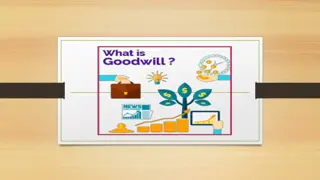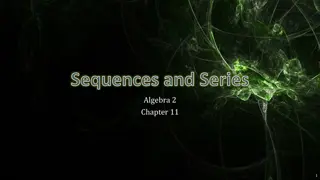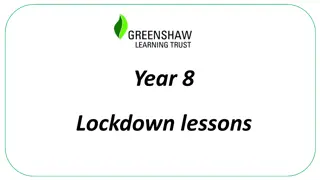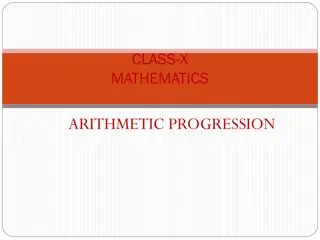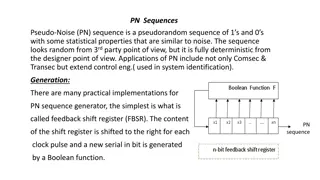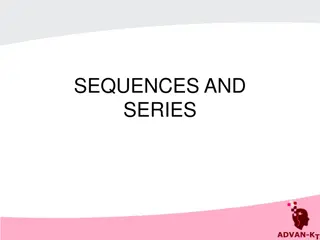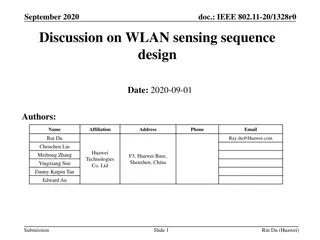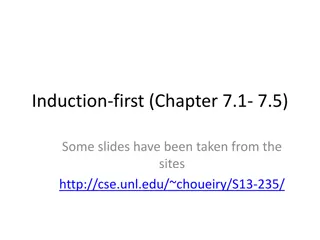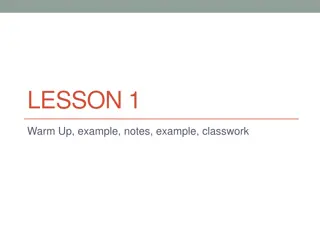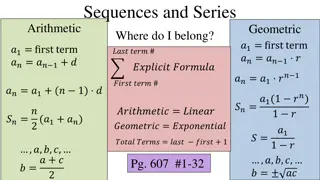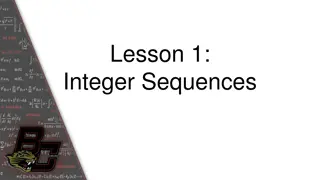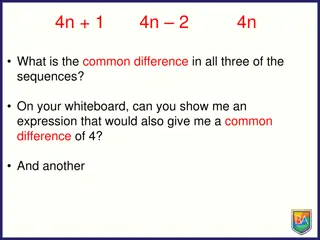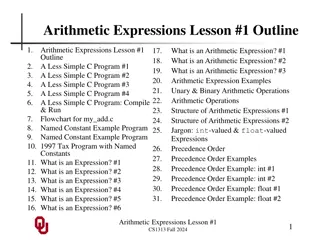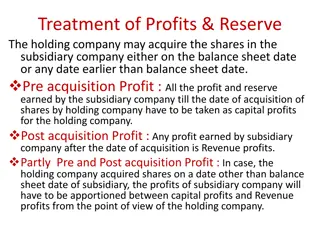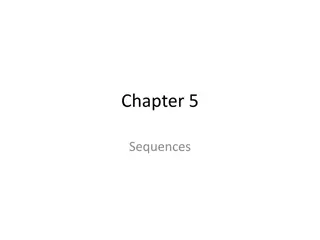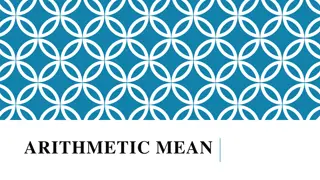Understanding Arithmetic Sequences and Series in Business Profits
Learn how to model and calculate business profits using arithmetic sequences and series. Explore a scenario where profits increase annually until reaching a constant level, and see the impact of different growth rates on financial projections. Understand the implications of using mathematical models in business forecasting.
Download Presentation

Please find below an Image/Link to download the presentation.
The content on the website is provided AS IS for your information and personal use only. It may not be sold, licensed, or shared on other websites without obtaining consent from the author. Download presentation by click this link. If you encounter any issues during the download, it is possible that the publisher has removed the file from their server.
E N D
Presentation Transcript
Teachings for Section Teachings for Section 3 3I I
??=? ??= ??? 1 ??=? 1 ?? (1 ?) ? ??= ? + (? 1)? ??=? 22? + ? 1 ? ? = 1 ? Sequences and Series 2? + ? You need to be able to use your knowledge of sequences to model situations given in context ? = ? ??= 100000 ? = 20000 ? = 5000 ??= ? + (? 1)? Sub in values Bruce starts a new company. He estimates that in Year 1 his profits will be 20000, and he predicts that his profits will increase by 5000 per year from that point on. He then models that once his annual profits reach 100000, they will then remain constant. 100000 = 20000 + ? 1 5000 Subtract 20000 80000 = ? 1 5000 Divide by 5000 16 = ? 1 Add 1 17 = ? a) Calculate the profit for Bruce s business in the first 20 years So the first 17 terms follow the pattern stated in the question We will need to find out when his profits reach 100000 per year, since at this point the pattern changes The total money earned will therefore be the sum of these first 17 terms, plus 300000 extra for Years 18, 19 and 20. It starts as an arithmetic series 3I
??=? ??= ??? 1 ??=? 1 ?? (1 ?) ? ??= ? + (? 1)? ??=? 22? + ? 1 ? ? = 1 ? Sequences and Series 2? + ? You need to be able to use your knowledge of sequences to model situations given in context ? = 17 ??= 100000 ? = 20000 ? = 5000 ??=? 22? + ? 1 ? Sub in values Bruce starts a new company. He estimates that in Year 1 his profits will be 20000, and he predicts that his profits will increase by 5000 per year from that point on. He then models that once his annual profits reach 100000, they will then remain constant. ??=17 2(20000) + 17 1 5000 2 Calculate ??= 1020000 Add on the extra 300000 ??= 1320000 a) Calculate the profit for Bruce s business in the first 20 years First 17 terms, then add 300000 3I
??=? ??= ??? 1 ??=? 1 ?? (1 ?) ? ??= ? + (? 1)? ??=? 22? + ? 1 ? ? = 1 ? Sequences and Series 2? + ? A possible reason would be that it is unlikely that Bruce s profits will increase by the exact same amount every year You need to be able to use your knowledge of sequences to model situations given in context Bruce starts a new company. He estimates that in Year 1 his profits will be 20000, and he predicts that his profits will increase by 5000 per year from that point on. He then models that once his annual profits reach 100000, they will then remain constant. a) Calculate the profit for Bruce s business in the first 20 years ??= 1320000 b) State a reason why this model might not be suitable 3I
??=? ??= ??? 1 ??=? 1 ?? (1 ?) ? ??= ? + (? 1)? ??=? 22? + ? 1 ? ? = 1 ? Sequences and Series 2? + ? You need to be able to use your knowledge of sequences to model situations given in context ? = 20 ??= ? ? = 20000 ? = 1.05 ??=? 1 ?? (1 ?) Bruce starts a new company. He estimates that in Year 1 his profits will be 20000, and he predicts that his profits will increase by 5000 per year from that point on. He then models that once his annual profits reach 100000, they will then remain constant. Calculate ??=20000 1 1.0520 (1 1.05) Calculate ??= 661319.08 Bruce s financial advisor says that it is more likely that his profits would increase by 5% per year. Using this model instead, calculate the profits that Bruce will make in the first 20 years. Increasing by 5% is calculated by multiplying by 1.05 1.05 is therefore the common ratio 3I
??=? ??= ??? 1 ??=? 1 ?? (1 ?) ? ??= ? + (? 1)? ??=? 22? + ? 1 ? ? = 1 ? Sequences and Series 2? + ? You need to be able to use your knowledge of sequences to model situations given in context ? = 5 ??= ? ? = 2 ? = 0.5 Be careful here. If we include the start width, then after 4 folds, we will be on the 5th value in the sequence A piece of A4 paper is folded in half repeatedly. The thickness of the sheet is 0.5mm. ??= ??? 1 Sub in values ??= 0.5(2)5 1 a) Work out the thickness after 4 folds b) Work out the thickness after 20 folds c) State one reason why this might be an unrealistic model Calculate ??= 8 Each fold will double the thickness of the sheet The starting thickness is 0.5mm 3I
??=? ??= ??? 1 ??=? 1 ?? (1 ?) ? ??= ? + (? 1)? ??=? 22? + ? 1 ? ? = 1 ? Sequences and Series 2? + ? You need to be able to use your knowledge of sequences to model situations given in context ? = 20 ??= ? ? = 2 ? = 0.5 Be careful here. If we include the start width, then after 20 folds, we will be on the 21st value in the sequence A piece of A4 paper is folded in half repeatedly. The thickness of the sheet is 0.5mm. ??= ??? 1 Sub in values ??= 0.5(2)21 1 a) Work out the thickness after 4 folds b) Work out the thickness after 20 folds c) State one reason why this might be an unrealistic model Calculate ??= 524288 8?? = 524.288? Each fold will double the thickness of the sheet The starting thickness is 0.5mm 3I
??=? ??= ??? 1 ??=? 1 ?? (1 ?) ? ??= ? + (? 1)? ??=? 22? + ? 1 ? ? = 1 ? Sequences and Series 2? + ? You need to be able to use your knowledge of sequences to model situations given in context A piece of A4 paper is folded in half repeatedly. The thickness of the sheet is 0.5mm. PAPER FOLDING THEOREM PAPER FOLDING THEOREM a) Work out the thickness after 4 folds b) Work out the thickness after 20 folds c) State one reason why this might be an unrealistic model 8?? 524.288? It is not possible to fold the piece of paper beyond a certain amount, so the model is unrealistic 3I


